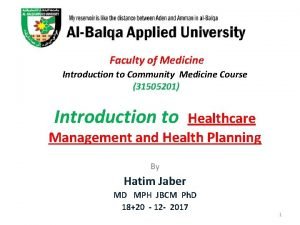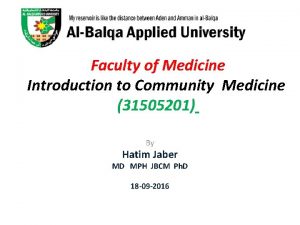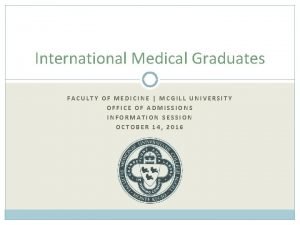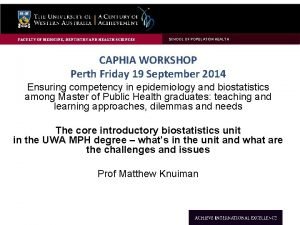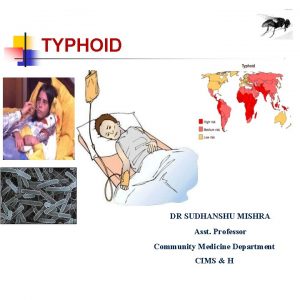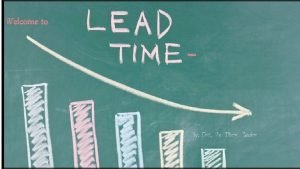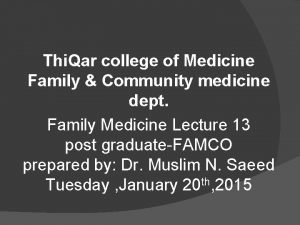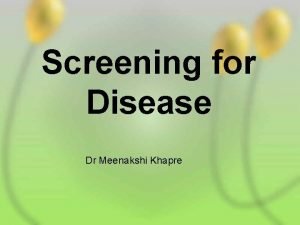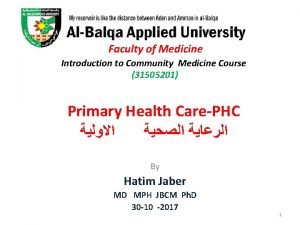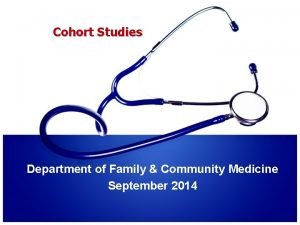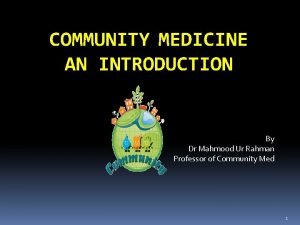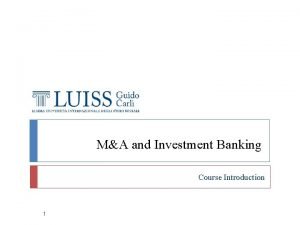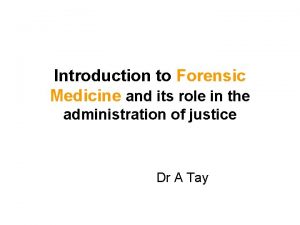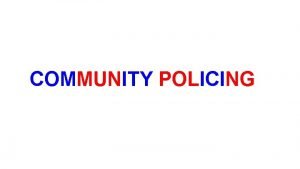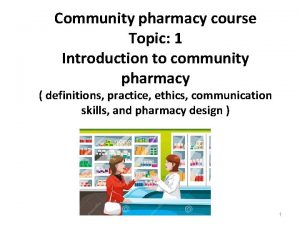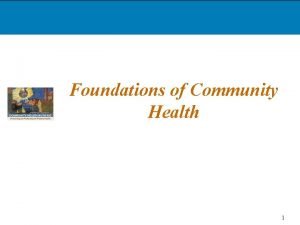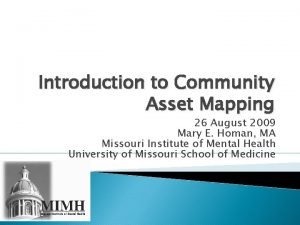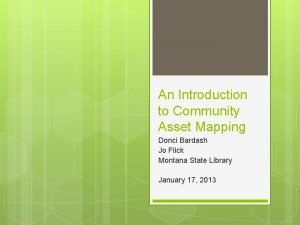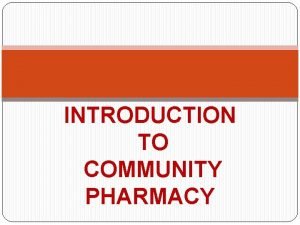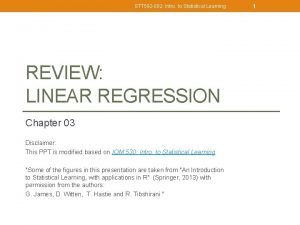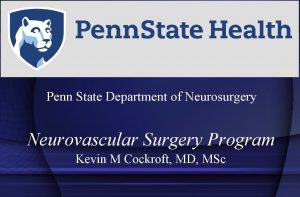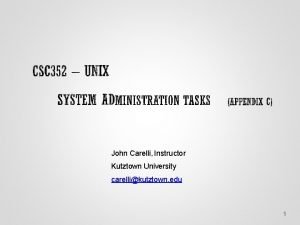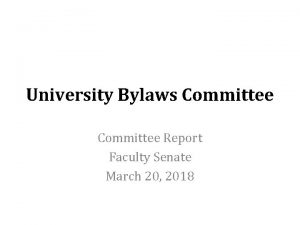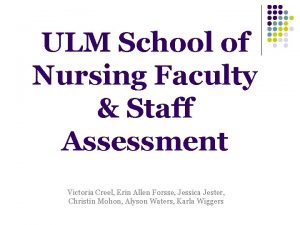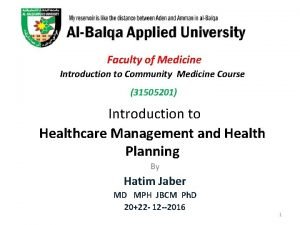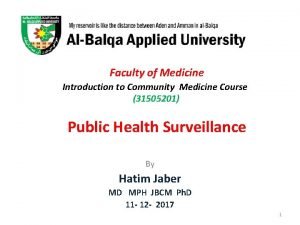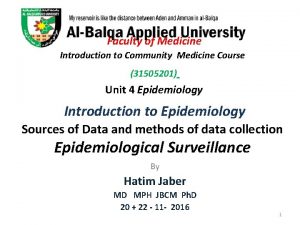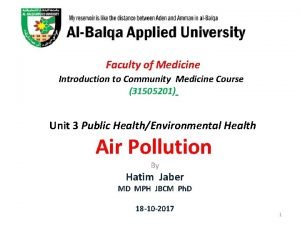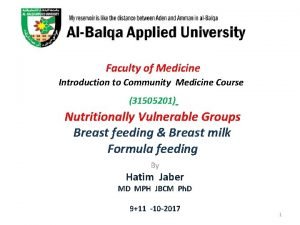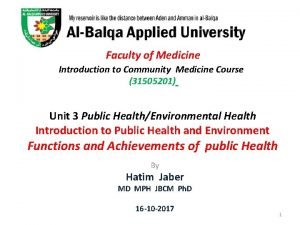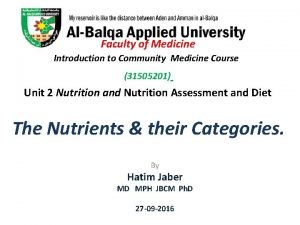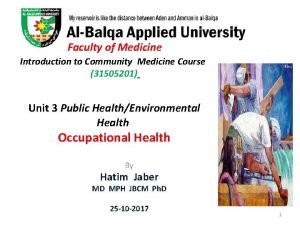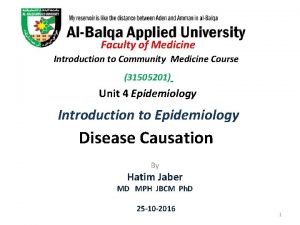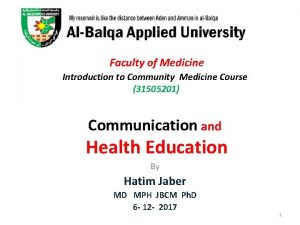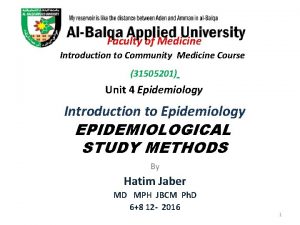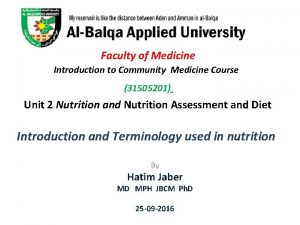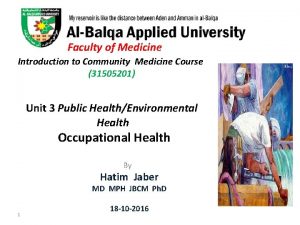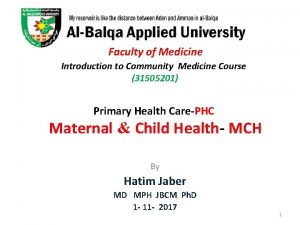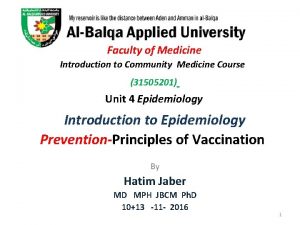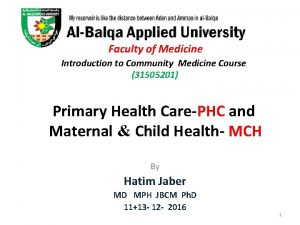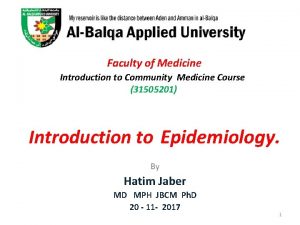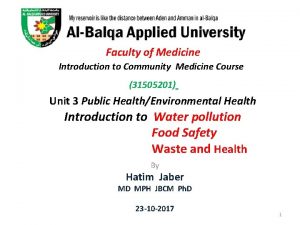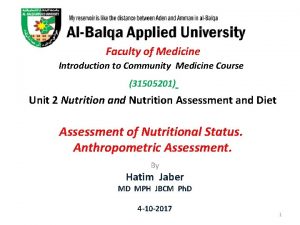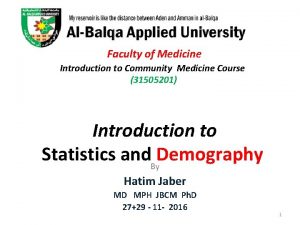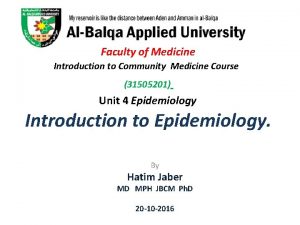Faculty of Medicine Introduction to Community Medicine Course




































































- Slides: 68

Faculty of Medicine Introduction to Community Medicine Course (31505201) Communication and Health Education By Hatim Jaber MD MPH JBCM Ph. D 4‐ 12‐ 2017 1

2

AIDS and sexually transmitted diseases » World AIDS Day » 2016 3

4

5

6

Post midterm • Week 8 Unit 6: Demography and Data • Week 9 Midterm assessment (Exams. )15 -11 -2017 • Week 10 Unit 8 Introduction to Epidemiology. • Week 11 Unit 9: Prevention and Control of Diseases Causation • Week 12 Unit 10: Communication and Health Education • Week 13 Unit 11: Public Health Surveillance and Screening • Week 14 Unit 12: Health Administration and healthcare management • Week 15 Unit 13: Revision and Health Research • Week 16 Final assessment (Exams. ) 7

Presentation outline Time Define terms: communication, health education 08: 00 to 08: 15 Communication process, types and skills 08: 15 to 08: 30 Effective Communication Skills 08: 30 to 08: 45 Barriers (personal, environmental) to effective communication Step‐Models In Communication 08: 45 to 09: 00 to 09: 15 8

Prevention • The goals of medicine are to promote health, to preserve health, to restore health when it is impaired, and to minimize suffering and distress. • These goals are embodied in the word "prevention" 9

Leavell’s Levels of Prevention Stage of disease Level of prevention Type of response Pre‐disease Primary Prevention Health promotion and Specific protection Latent Disease Symptomatic Disease Secondary prevention Tertiary prevention Pre‐symptomatic Diagnosis and treatment • Disability limitation for early symptomatic disease • Rehabilitation for late Symptomatic disease A fourth level, called primordial prevention, was later added. 10

Levels of Prevention Table 11

Primary prevention Achieved by Health promotion • Health education • Environmental modifications • Nutritional interventions • Life style and behavioral changes Specific protection • Immunization and seroprophylaxis • Use of specific nutrients or supplementations • Protection against occupational hazards • Safety of drugs and foods • Control of environmental hazards, e. g. air pollution 12

HEALTH PROMOTION The process of enabling people to increase, control over and to improve health. Intervention are: Health Education: The extension to all people of the benefits of medical, psychological and related knowledge is essential to the fullest attainment of health. Targets maybe general public, patients, priority groups, health providers, community leaders and decision‐makers. 13

“Health education is a process that informs, motivates and helps people to adopt and maintain healthy practices and lifestyles, advocates environmental chances as needed to facilitate this goal and conducts professional training and research to the same end” 14

COMMUNICATION for HEALTH EDUCATION What is communication? • Is it Transfer, Conveying or Exchange? • Communication is derived from ‘communis’ which means COMMONNESS or SHARING. 15

Communication • The exchange of meanings between individuals or groups through a common system of symbols. • Communication takes place when one’s mind so acts upon its environment that another mind is influenced, and in that other mind an experience occurs which is like the experience in the first mind, and is caused in part by that experience. 16

Communication is a dynamic process in which feelings & ideas are expressed as messages sent, received &comprehended. • It’s sharing information and has double way flow. • Communication is a Series of Experiences • How it is received depends on a set of events, stimuli, that person is exposed to. • How you say what you say plays an important role in communication. 17

18

Elements of communication: • • • The sender or the educator: The message (topics of health talk): The methods & channels of communication: The receiver/s (audience/s): Feedback ( positive or negative): Effect ( end result) : 19

Communication Process SMCR Model 20

Communication Process • Who says what to whom with what effect? • Linear model – source – person on phone – encoder – mouthpiece on phone – message – words the person speaks – channel – phone lines – decoder – earpiece, other end – receiver – person listening on phone • 21

Communication Process – cont’d • Issues – entropy – static in transmission of message; not understandable • Solution – feedback – helps to avoid entropy or redundancy – repetition of elements within a message that prevent communication of message 22

Communication Process – cont’d • Psychological effects – Perceptions – Attitudes and behaviors – Cognitive dissonance 23

Sender Must know: • • • Objectives Audience: interests & needs Message Channels of communication Professional abilities Limitations Sender Related Factors affecting communication process: • Similarity and sharing characteristics. • Whether he practices what he advises. • He should be oriented by his audience ( he should know characteristic personal and social variables of the recipients • Attitude of the recipients toward the message of education e. g. family planning and birth control. 24

Receiver • Single person or Group of people • Controlled audience • Uncontrolled audience 25

Message Must be: • In line with the objective(s) • Meaningful • Based on felt needs • Clear and understandable • Specific and accurate • Timely and adequate • Fitting the audience • Culturally and socially acceptable 26

Channel • Interpersonal communication • Mass media • Traditional or folk media Feedback • Flow of information from the audience to sender • Opportunity to the sender to modify his message 27

Objective of Communication • To form and establish a relationship between a sender and a receiver. Aim of Communication: • - To Satisfy physical and psychological needs. • ‐To build trust & maintain relationship with families and individuals. • ‐To alleviate distress & reassure of patient. • ‐To convey feeling & give or share information. • ‐To make decision & persuade others to change attitude and behavior. • ‐To solve problem 28

We call it communication, but it’s really about relationship The mechanics of good communication are valuable as tools to help you create a trusting doctor-patient relationship. 29

Steps to achieve the objective Presentation of a stimulus Perception of the stimulus by the receiver Interpretation of the stimulus by the receiver Trial response to the stimulus Perception of the consequences of the trial response • Re‐interpretation of the consequences, and the making of further responses • Development of a stable stimulus‐response relationship. • • • 30

Step‐Models In Communication • A‐I‐D‐A Attention • A‐I‐E‐T‐A • Attention • Interest • Desire • Evaluation • Action • Trial • Adoption 31

Types of Communication One‐way communication (Didactic method) Two‐way communication (Socratic method) Verbal communication: direct and non‐direct Non‐verbal communication Formal and Informal communication Visual communication Telecommunication and Internet 32

Types of Communication Settings • Intrapersonal • Interpersonal • Small group • Public • Mass communication 33

Communication Types Forms of communication: • Non verbal communication: by movements and signs. • Nonvocal – – – signals signs symbols icons gestures proxemics • Verbal communication: by saying or writing. • Vocal • Mass media – public opinion – attitudes – persuasion 34

VERBAL: Verbal communication includes: • Language • Quality of voice • Kind of speaking • Interruption • Hesitation • Silence 35

Non verbal communication • NON-VERBAL: Non verbal communication includes all forms of communication that doesn’t include the actual meaning of words. – In face to face communication, we should be sensitive to the effect of non verbal communication for example; setting behind a disk can reinforce the barrier between health workers and community, looking at watch, looking away may be taken as showing boredom. • Non verbal communication can be interpreted according to the culture of the community 36

Non verbal communication Forms of Non verbal communication: • Body language which includes: Eye contact, body movement, gesture & mimics. • Object language which includes: Dress, Beard and hair, Equipments. • Space language which includes: Distance , Forbidden zone. 37

Communication skills • Communication skills are required to make communication effective, the following are the skills required at source level. These include: • greeting skills, • speaking skills, • listening skills, • questioning skills, • and summarizing skills. The non‐verbal skills play an important role. It affects the communication process. Body language is an important constituent of non-verbal communication and consists of gesture, postures facial expressions, eye contact, manipulating the eyebrows etc. 38

Key Communication Skills: (summarized in acronym CLEAR) • Clarify ( C ) • Listen ( L ) • Encourage ( E ) (Helping People to talk) • Appreciate ( A ) • Reassure ( R ) 39

Good communication technique • • Source credibility. Clear message. Good channel: individual, group & mass education. Receiver: ready, interested, not occupied. Feed back. Observe non‐verbal cues. Active listing. Establishing good relationship. 40

What is Effective Communication? • When a sender elicits an intended response from his/her receiver, communication is effective. • When a sender elicits intended response repeatedly, he/she is not only an effective communicator but also a successful and influential communicator. 41

Effective Communication Skills Eye contact & visible mouth Some questions Encouragement to continue Body language Effective Communication skills Silence Smiling face Summarising what has been said Checking for understanding 42

Standards of Effective Communication • Complete – Communicate all relevant information • Clear – Convey information that is plainly understood • Brief – Communicate the information in a concise manner • Timely – Offer and request information in an appropriate timeframe – Verify authenticity – Validate or acknowledge information 43

Principles of effective communication • ensures interaction rather than direct transmission • reduces unnecessary uncertainty • requires planning and thinking in terms of outcomes • demonstrates dynamism – what is appropriate for one situation is inappropriate for another. Achieving this dynamism requires flexibility, responsiveness and involvement • follows the helical model (what one person says influences what the other says in a spiral fashion so that communication gradually evolves through interaction). 44

Successful communication of message depends on 5 components: • • • credibility of message source message design delivery channel target audience targeted behavior 45

Mass Communication – steps needed for individual to be persuaded to follow a behavior • exposure to the message • • attention to the message • interest in/personal • relevance of message • • understanding the message • • personalizing the behavior • to fit one’s life • accepting the change remembering the message and continuing to agree with it being able to think of it making decisions based on bringing the message to mind behaving as decided receiving + reinforcement for behavior 46

Communication Barriers • Social and cultural gap between the sender and the receiver • Limited receptiveness of receiver • Negative attitude of the sender • Limited understanding and memory • Insufficient emphasis by the sender (health professional) • Contradictory messages • Health education without identifying the “needs "of the community 47

Barriers to Effective Communication Language Time Noise Other people Distractions Barriers to effective communication Put downs Too many questions Distance Lack of interest Discomfort Disability with the topic 48

Communication is a 2‐way process Communication skills involve: sender • Listening to others (Receiving) receiver message • Asserting/ Expressing (Sending) • Barriers to communication can lead to misunderstanding and confusion sender values and attitudes “generation gap” language Cultural differences noise hearing receiver 49

The Art of Listening • “If we were supposed to talk more than listen, we would have been given two mouths and one ear. ” • Mark Twain Requirement for effective Listening: • Picking up cues (verbal or non verbal): to help patient to articulate their concerns and feelings. • Facilitation: to help patient to talk freely about his problem. • Clarification: of any understand. • Reflection: reflection back to the patient of what he just said to help him to proceed with his complain. • Silence: it is valuable to reflect on what has been said. • Summarizing : it is important to : • Check accuracy of history taking • Help to review the patient’s needs. • Help to discuss the patient’s problems and facilitate discussion. 50

The Communication Equation • What you hear • • Tone of voice Vocal clarity • Verbal expressiveness 40% of the message • What you see or feel • • • Facial expression Dress and grooming Posture Eye contact Touch • Gesture • WORDS … message! 50% of the message 10% of the 51

Educator • Personnel of health services. • Medical students, nursing & social work. • School personnel. • Community leaders & influencials. Requirements: • Personality: popular, influential and interested in work. • Efficiency trained and prepared for the job. • Must show good examples. 52

Practice 1‐Individual Face to face Education through spoken word. A‐ Occasions of health appraisal. B‐ Home visits Nurses Health visitors Social workers 53

2‐Group a. Lessons and lectures in schools. b. lectures in work places e. g. factories. c. Demonstration and training 3‐ Mass media. 1. Broadcasting: radio & TV. 2. Written word: newspapers, posters, booklets. 3. Others e, g, theaters. 54

Major Variables in Behavior Change Thoughts and ideas inside a person’s mind have significant influence on an individual’s health behaviors. These variables interact with social and environmental factors and it is the synergy among all these influences that operate on behavior. • Knowledge: An intellectual acquaintance with facts, truth, or principles gained by sight, experience, or report. • Skills : The ability to do something well, arising from talent, training, or practice. 55

Major Variables in Behavior Change • Belief : Acceptance of or confidence in an alleged fact or body of facts as true or right without positive knowledge or proof; a perceived truth. • Attitude: Manner, disposition, feeling, or position toward a person or thing. • Values: Ideas, ideals, customs that arouse an emotional response for or against them. 56

Health Belief Model INDIVIDUAL PERCEPTIONS MODIFYING FACTORS Demographic Variables Perceived susceptibility Perceived severity LIKELIHOOD OF ACTION Socio-psychological Variables Perceived threat Perceived benefits of preventive action Likelihood of taking recommended preventive health action Perceived barriers to prevent action Cues to Action Information Reminders Persuasive communications Experience 57

Categories of Belief • • Perceived Seriousness Perceived Susceptibility Perceived Benefits Perceived Barriers 58

Categories of Belief Seriousness • Relative severity of the health problem. – E. g. Seriousness of hepatitis encourages individuals to get the hepatitis vaccine. Susceptibility • Nature and intensity of perceptions affect willingness to take preventive action. 59

• Perceived Seriousness • Perceived seriousness relates to one’s view of the severity of the condition if they do not practice the preventive behavior. People are more likely to practice health promotion if they are concerned about a serious disease consequence if they don’t. For example, AIDS, if they don’t practice safe sex, or hepatitis if they do not get the hepatitis vaccine. 60

• Perceived Susceptibility • This is “how vulnerable” do I feel related to a specific health problem? People’s perception of their vulnerability may not match their true risk. Smokers may feel protected from lung cancer and not personally feel at risk for the disease, for example. In reality, smokers have a significantly higher risk of developing the disease than non-smokers. • The Health Belief Model has helped confirm that the more susceptible individuals feel about a health condition, the more likely they are to take protective action, • Example: Elderly who perceive they will get the flu from frequent exposure will get the shot. 61

Categories of Belief Benefits • Anticipated value of the recommended course of action. • Must believe recommended health action will do good if they are to comply. Barriers • Perception of negative consequences • Greatest predictive value of whether behavior will be practiced. 62

Stages of Change • • • Precontemplation Contemplation Preparation Action Maintenance 63

Precontemplation • Definition – Not considering changing their behavior – Lack of awareness • Intervention Approach – Novel information – Persuasive communications – Experiences 64

Contemplation • Definition – Person is beginning to consider behavior change – Important stage of information acquisition • Intervention Approach – Motivated by role modeling and persuasive communications – Receptive to planned or incidental learning experiences. 65

Preparation • Definition – Deciding to change by preparing and experimenting. – Psychological preparation of trying on or visualizing new behaviors and sharing the idea with others. Deciding to change. • Intervention Approach – How-to information, skill development, attitude change 66

Action • Definition – Actually trying the new behavior • Intervention Approach – Skill – Reinforcement – Support – Self-management – Attitude and attribution change 67

Maintenance • Definition – Establishment of the new behavior – Taking on the new attitudinal and environmental supports • Intervention Approach – Relapse prevention skills – Self-management – Social and environmental support 68
 Introduction to community medicine
Introduction to community medicine Introduction to community medicine
Introduction to community medicine Hubert kairuki memorial university faculty of medicine
Hubert kairuki memorial university faculty of medicine Solid thyroid nodule
Solid thyroid nodule Mrbs scholarship
Mrbs scholarship Applied medical sciences
Applied medical sciences Territorial matrix vs interterritorial matrix
Territorial matrix vs interterritorial matrix Faculty of veterinary medicine cairo university logo
Faculty of veterinary medicine cairo university logo Hacettepe university faculty of medicine
Hacettepe university faculty of medicine دانشگاه دامپزشکی تهران
دانشگاه دامپزشکی تهران Semmelweis university faculty of medicine
Semmelweis university faculty of medicine Faculty of medicine mcgill
Faculty of medicine mcgill Faculty of veterinary medicine cairo university
Faculty of veterinary medicine cairo university Pubh4401
Pubh4401 Emory dermatology clinic
Emory dermatology clinic Cairo university faculty of veterinary medicine
Cairo university faculty of veterinary medicine Faculty introduction speech
Faculty introduction speech English bond t junction
English bond t junction Course title and course number
Course title and course number Course interne course externe
Course interne course externe Drinking water
Drinking water Lt lead time
Lt lead time Types of family in community medicine
Types of family in community medicine Concept of lead time
Concept of lead time 10 importance of health education
10 importance of health education Types of family in community medicine
Types of family in community medicine Cohort study community medicine
Cohort study community medicine Duke medicine grand rounds
Duke medicine grand rounds Seqs community medicine
Seqs community medicine Community action cycle
Community action cycle Introduction to banking course
Introduction to banking course Imbe introduction course v2
Imbe introduction course v2 Software engineering 1 course outline
Software engineering 1 course outline Ron had a course introduction
Ron had a course introduction Cleft sentences example
Cleft sentences example Awe aldermaston
Awe aldermaston Introduction to forensic medicine
Introduction to forensic medicine Introduction of community policing
Introduction of community policing The apprentice pharmacist
The apprentice pharmacist Introduction of community health nursing
Introduction of community health nursing An introduction to community asset mapping
An introduction to community asset mapping Community asset mapping examples
Community asset mapping examples Introduction to community pharmacy
Introduction to community pharmacy University of split faculty of maritime studies
University of split faculty of maritime studies University of bridgeport engineering
University of bridgeport engineering University of bridgeport computer science
University of bridgeport computer science Alamo colleges faculty salary schedule
Alamo colleges faculty salary schedule Hahnville high school powerschool
Hahnville high school powerschool Importance of faculty in higher education
Importance of faculty in higher education 002
002 Penn state neurosurgery
Penn state neurosurgery Mercy faculty forward
Mercy faculty forward Lee kong chian faculty of engineering and science
Lee kong chian faculty of engineering and science Carelli
Carelli Florida state university masters in computer science
Florida state university masters in computer science Faculty of business and economics mendel university in brno
Faculty of business and economics mendel university in brno Electrical engineering umd
Electrical engineering umd Factors influencing faculty staff relationship
Factors influencing faculty staff relationship Nit calicut chemistry department faculty
Nit calicut chemistry department faculty Faculty of civil engineering ctu prague
Faculty of civil engineering ctu prague Faculty 180 ecu
Faculty 180 ecu Benha faculty of engineering
Benha faculty of engineering Singularity executive program
Singularity executive program Faculty of law maastricht
Faculty of law maastricht Medical faculty in novi sad dean
Medical faculty in novi sad dean Umn faculty dental clinic
Umn faculty dental clinic Sjsu faculty affairs
Sjsu faculty affairs Unlv faculty senate
Unlv faculty senate Ulm nursing faculty
Ulm nursing faculty
